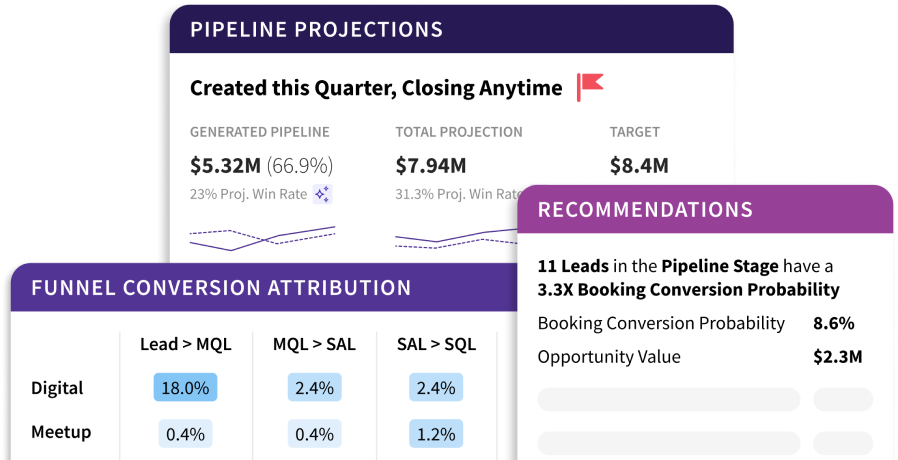
Many companies face challenges converting leads into opportunities. Most often, this is due to two common issues. Solving these can significantly improve lead conversions by up to 10X and keep your sales pipeline full.
The first issue is miscommunication and context loss between marketing and sales teams. When lead handoff is bobbled, leads are dropped and conversion rates suffer.
The second issue is a lack of pipeline data and insights to understand how to improve conversion rates.
Focus on these three key strategies to tackle these challenges and improve lead-to-opportunity conversion rates: unify your funnel, optimize lead progression, and prevent funnel leakage.
1. Embrace the Unified Funnel
A unified sales and marketing funnel provides a complete view of the buyer's journey from first-time site visitors to closed deals. Bringing all your campaign data together provides a holistic view that lets you monitor leads' progress, identify bottlenecks, and find leakage points.
A unified funnel also fosters alignment between marketing and sales teams and enables prioritization based on data-driven insights.
What does a unified sales and marketing funnel enable?
- Gain Comprehensive Visibility: By having a unified funnel, the organization gains complete visibility into the entire customer journey. This visibility enables teams to see how prospects move through each stage, identify potential drop-offs, and understand conversion rates at different points in the funnel.
- Monitor Progress and Performance: A unified funnel allows for real-time monitoring of leads as they progress through the various stages. Marketing and sales teams can track the movement of prospects and assess the performance of each stage. This monitoring facilitates a data-driven approach, enabling quick adjustments to strategies if certain stages are underperforming.
- Identify Bottlenecks: With a unified funnel, it becomes easier to identify bottlenecks and pain points in the customer journey.
- Find Leakage Points: Leakage points refer to areas in the funnel where leads leak out or fall through the cracks. These may be instances of miscommunication, lack of follow-up, or ineffective nurturing.
- Align Marketing and Sales: One of the significant benefits of a unified funnel is that it fosters better alignment between the marketing and sales teams
2. Influence Pipeline Progression
Instead of focusing solely on generating more leads, the emphasis should be on optimizing conversion rates throughout the lead-to-opportunity journey. By understanding how leads and accounts progress through the funnel, teams can allocate their time and budget more effectively. This improves ROI by making the most of the leads you have.
How can you influence pipeline progression?
- Improve Lead Quality: Conversion rate optimization places a higher value on lead quality rather than sheer quantity. By nurturing and qualifying leads more effectively, marketing teams can ensure that only the most qualified leads progress to the sales team. This leads to better alignment between marketing and sales, reducing the chances of wasted effort on leads that are not likely to convert.
- Enhance Customer Experience: A focus on conversion rate optimization means a greater emphasis on understanding and addressing pain points and objections that leads may have as they move through the funnel. By providing relevant information and solutions at each stage, marketers can create a smoother and more engaging customer experience, increasing the likelihood of conversion.
- Monitor Performance: Optimization is an iterative process that requires ongoing analysis and refinement. By constantly monitoring conversion rates and analyzing performance, marketing teams can identify areas that need improvement and implement changes to boost conversion rates over time.
3. Stop Pipeline Leakage
The presence of multiple systems and unclear ownership of lead-to-opportunity and pipeline generation can lead to pipeline leakage. To prevent this, teams need to collaborate and identify where leads are lost within the funnel. They need to address bottlenecks and work together to ensure more leads convert to the next stage.
How do you stop a leaking pipeline?
- Streamline Systems and Integrate Data: To address the challenges posed by multiple systems, it's crucial to streamline and integrate the various tools and platforms used by different teams, such as marketing automation, CRM, and sales enablement tools. By consolidating data into a centralized system, the organization gains a unified and coherent view of the customer journey, enabling smoother handoffs between teams and reducing the risk of data silos and miscommunication.
- Define Roles and Ownership Clearly: Unclear ownership of lead-to-opportunity and pipeline generation can lead to confusion and inefficiencies. It's essential to establish clear roles and responsibilities for each stage of the customer journey. This includes defining the handoff process from marketing to sales, establishing criteria for lead qualification, and determining the ownership of each stage of the pipeline. Clear ownership ensures that leads are properly nurtured and attended to, reducing the likelihood of pipeline leakage.
- Implement Lead Nurturing Strategies: Not all leads are immediately ready to become opportunities or make purchasing decisions. Lead nurturing is essential to maintain engagement and build relationships with prospects until they are ready to move forward in the buyer's journey. By implementing effective lead nurturing strategies, organizations can reduce pipeline leakage and keep prospects engaged until they are sales-ready.
A data-driven approach, combined with a unified funnel and collaboration between marketing and sales teams, is crucial for significant improvements in lead-to-opportunity conversion rates.
By understanding what drives growth and identifying friction points in the funnel, companies can focus their efforts and resources more effectively to increase conversion rates and improve their bottom line.






